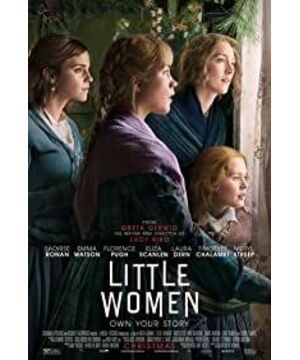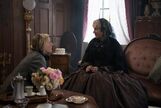In "My Gifted Girlfriend," Lila and Lennon, girls from the slums of Naples, bought a copy of "Little Women" with a precious sum of money from a community bully. The two girls hugged each other and sat on the stone benches in the patio garden. Violence was unfolding not far from them, and they read "Little Women" aloud over and over again, until the spine of the book fell off.
This work, published by Louisa May Alcott in 1868, was published earlier than "The Adventures of Tom Sawyer" and "The Adventures of Huckleberry Finn". Before the appearance of these boys' literary images representing the adventurous spirit, Louisa May used her personal experience and warm brushstrokes to weave a limited Christmas story for the girls, and also contributed to the history of literature like the March family. A group portrait of women with far-reaching influence.
"Little Women" is an uncomplicated story. It is about a warm family life, about the joy and regret of growing up, about sisters fighting each other and intimate, and about the ordinary and impermanent destiny itself, with a sense of substitution. The role of, has taught many girls how to deal with the identity dilemma of being a woman. But perhaps most importantly, "Little Women" created Jo. This rebellious and independent image of a female writer has become the starting point for countless girls’ creative dreams, inspiring everything from Beauvoir to Elena Ferrante. JK Rowling to Patty Smith's many female authors.
This well-known literary classic has been put on the big and small screens several times in the more than a century after it was written. The earliest film and television adaptation was a silent film that has been lost. After that, "Little Women" was adapted into several film versions in 1933, 1949, and 1994, and several relatively unpopular TV minis. Drama and a Japanese animation. The classic boys and girls characters in the book have experienced generations of big stars, (including Catherine Hepburn, Elizabeth Taylor, Winona Reid, Christian Bell,...), and they are also in different eras. A certain fixed and cordial face was formed in the hearts of the audience.
When the news that Greta Gerweig was about to remake "Little Women" came out, many people were puzzled. On the one hand, "Little Women" does not resemble Gerweig's style from head to toe. Gerweig’s screen image as an actor is an interesting, literary and somewhat clumsy modern New York girl, who seems to have nothing in common with the 19th-century Massachusetts country girls, and her directorial debut "Miss Bird" is so personal. The originality also makes people wonder why she had to adapt a classic work by others.
On the other hand, the film and television adaptation of "Little Women" has already had so many jewels ahead, especially the 94 version of "Little Women" directed by another female director Gillian Armstrong, which is of high quality in all aspects. Highly recognized masterpiece. In this case, is it necessary to spend a lot of time to make another version?
The answer sheet that Geweig handed over at Christmas perfectly answered this question. Those bold adaptations and reinterpretations that are different from the previous work are proof of the necessity of the new version of "Little Women" and why each era needs its own "Little Women".
1 Bold and cruel non-linear narrative
The non-linear narrative structure is the biggest and most obvious difference between the new version of "Little Women" and the original and previous works. The "Little Women" that readers are familiar with is divided into two parts and published in chronological order. It tells that the daughters of the March family grew up from girls to girls and finally married into women. The new version of "Little Women" simply broke This linear narrative directly pulls the audience into a darker adult world, and then through flashbacks, shuttles back and forth between the warm girlhood of the sisters seven years ago and the difficult reality seven years later.
So at the beginning of the new version of "Little Women", the audience saw Jo writing and raising his family alone in New York, Meg was a tight housewife, Amy was studying painting in Paris, and Beth was in distressing health. In this cruel reality, the story suddenly pulled back to Christmas seven years ago (that is, the node at which the novel started). At that time, all the joy, all the childish vigor and the warmth of gatherings were enveloped in a heartbreaking layer. The color of tragedy has become a kind of looking back and remembering.
The next two parallel timelines have been constantly reminding the audience that the beauty they watched has passed. Seven years ago, Laurie was like the fifth sister of the March family. Everyone played a farce affectionately in the attic, but the audience knew that Laurie had already become a decadent and alienated figure in reality. The beach full of joyful memories seven years ago became lonely and desolate in a blink of an eye, leaving only Jo and the seriously ill Beth leaning on and waiting for their fate.
This foreseeable perspective is quite ruthless. When the girls seven years ago dreamed of a grand future, they thought that they could do anything to become anyone, and that their family members would be together forever. And seven years later, they and the audience knew that those beautiful dreams had long since become impossible. possible. In fact, in this timeline seven years later, the four sisters of the March family never got together again.
When watching other adaptations that follow the growth path of the protagonists, the audience experienced the purest emotions of the moment, while the new version of "Little Women" brought a double time and space, more complicated and even more contradictory. Emotional experience.
For viewers who are not familiar with the plot of "Little Women" and don't know the ending of the characters, the new version of "Little Women" can be said to be a completely different story compared to the original. Generations of book fans have watched Jo and Laurie grow up together, and they will not be able to get together, but if it is for new audiences who watch "Little Women" for the first time, the non-linear narrative makes They knew the fact that Laurie was rejected by Jo from the beginning, and knowing the ending of a relationship in advance may completely affect the way they view the relationship. This completely reshaped narrative experience is very novel. The new audience is completely controlled by Geweig, and after this "Little Women", the CP fans of Amy and Laurie may increase rapidly.
Non-linear narrative also adds possibilities for more stylized and interesting editing. The four sisters’ appearances are smoothly intertwined. When Jo verbally mentioned Amy, he gave the perspective to her who was in Paris. When Meg sat down in front of the porch of his little house and looked far away, the camera followed Her gaze shifted to Beth in the old house. The most memorable parallel editing is Beth's two serious illnesses on two timelines, using matching shots to maximize the expectations of the audience and Jo, and then ushering in the most heartbreaking failure.
However, although nonlinear narrative has the above obvious advantages, it cannot be said to be a perfect choice. Because it is the same group of actors, the tight cut between the two timelines can sometimes make people feel lost. I don't know if we are seeing it seven years ago or seven years later.
In order to best distinguish the two timelines accurately and avoid confusion among the audience, "Little Women" has made three efforts. The color tone seven years ago was warm and colder seven years later, it is easy to distinguish visually; the current timeline uses dolly more, the lens is more stable, and there are fewer close-ups, while the past timeline uses Steadicam to create a dance-like Lightness; and the two online characters also have different hairstyles, allowing the audience to quickly make timeline judgments through obvious hairstyle changes.
However, despite these three aspects of insurance, this timeline jump still has certain risks. The most obvious trouble is on Amy. As the youngest sister in the family, Amy's age spans from twelve to twenty years old on the timeline seven years ago. In the previous version, Amy’s age treatment has always been a problem. The 49 version of Amy was starred by Elizabeth Taylor. In order to match the age of the actors at the time, the order of Amy and Beth at home had to be swapped; and the 94th version of "Little Women" ", choose to play the twelve-year-old Amy by Kirsten Dunst at the right age, and use two different actors to create the growth of the role on the screen and the passage of time.
In the new version of "Little Women", although Florence Pew, who plays Amy, is a very good actor, her slightly mature appearance and distinctive husky voice are not enough to fully convince the audience that she is acting A little girl, some of the shots of the girl Amy may cause misjudgments in time and space.
Another plot that may be confusing appears at the end. Jo, who was awakened from the sofa, sees Laurie. At this time, she is wearing long hair like seven years ago. Before Laurie speaks, the audience may not be able to tell which stage of their relationship is. Of course, this kind of treatment may deliberately create a sense of chaos when waking up from a dream and not knowing where you are. It is a small tease to the audience, but it must be said that this action deprives the audience of the standard of judgment. To a certain extent, the audience feels very insecure.
But in the end, Geweig is probably not afraid that the audience will feel insecure. This somewhat complicated narrative structure itself is asking the audience to take a small step outside of their comfort zone and invest more energy like a detective when watching movies, to capture the colors and camera movements on the screen, art and clothing. All the details in Huadao.
Whether this adaptation is an innovation worth encouraging or a superfluous dazzling technique is a matter of opinion for audiences with different viewing experiences, but this novel attempt, which is different from all predecessors, really breaks the original novel. The splicing into a story that only the film medium can perfectly present is enough to become the biggest reason for the necessity of this work.
2 "Inception" style ending
The new version of "Little Women" has an ending that has caused huge divergence among the audience. This is a situation that most of the previous classics adapted from film and television works did not have. Slate magazine even directly called this ending "a Inception style ending." Just as the fans of "Inception" had their own opinions on whether the spinning top should stop, the audience of "Little Women" also expressed their gratitude towards Jo. Did you really have different opinions with Professor Bhaer?
After reviewing the closing paragraph carefully, I tend to think that Jo was not with the professor at the end of this edition of "Little Women." The romantic part where Jo went to the train station to chase the professor was cross-edited with the dialogue between Jo and the publisher. Jo made it clear to the publisher that she didn't want the protagonist in the story to marry, but the publisher told her with a bit of force that the heroine in the story must either marry or die if the book is to make money.
In such a dialogue situation, there is a romantic scene of Jo Yuye chasing a man kissing under an umbrella. After this kiss, the publisher’s contented "very romantic, I like it" was immediately picked up, and even expressed enthusiastically. Chapter can be called "Under the Umbrella". This kind of treatment seems to strongly imply that the love story between Jo and the professor is just a fictional plot that Jo complies with the publisher's request and tells it jokingly.
Such an ending is a bold subversion of the original ending, but perhaps it is really close to the ending envisioned for Jo in the heart of the author Louisa May. Louisa May once wrote in her diary that her Jo should be lifelong unmarried and spiritually rich. In the final book, Jo’s marriage to the professor was the result of Louisa May’s compromise with readers and booksellers, because as published Shang said that the books of the heroine who did not marry in that era could not be sold.
There is no plot in the original work of "Little Women" where Jo is bargaining with the bookseller, and the negotiation and dialogue scene added by Gerweig seems to finally conform to the author's inner hope, giving Louisa May her desire That ending. This kind of space propaganda creation cannot be said to be unromantic, and Gerweig not only drastically changed Jo’s ending, but also used this dialogue and a very Cliche romantic comedy to confront Louisa May. Talk about the concessions and compromises experienced in that era.
Of course, the ending of "Little Women" is an open ending, and another explanation is completely tenable, that is, Jo is really with the professor. If romance is not important, Geweig will not replace the plain and informal middle-aged German professor in the original book with Louis Garrell, and Jo is not limited to the stereotyped independent female impression and boldly pursues true love and discards Self-enclosed loneliness is another kind of precious encouragement.
However, no matter which interpretation you agree with, perhaps Geweige’s ambiguous ending conveys the message: Is it really important whether Jo and the professor are together? No matter what happens between Jo and the professor is true Romance is still a fictitious ridicule, "Little Women" is finally fixed on Jo holding up his own work. Her identity as an author and the power of a woman to write about her own life have been affirmed and rewarded in this ending. This is the true happy ending provided by the new version of "Little Women". It is not a romantic wedding, but a book written by myself, which in itself is the biggest resistance to the ending written under the compromise at that time.
3 Money, ambition, and Amy March who was finally rectified
When I read "Little Women" when I was a child, the most impressive thing was that Jo sold his hair for money. It made me know for the first time that hair can be sold for money, which is not very useful knowledge. The new version of "Little Women" movie, compared with the previous version, further emphasizes the economic factors in the life of March's family. Almost every woman is troubled by money to varying degrees. Jo is working hard to support the family, Meg is careful to keep the family, and Amy For the future economic situation of the family (and to a certain extent for myself), I want to marry a rich family.
When the image of patriarchy in the family was absent for a long time (not to mention that the father still looked unreliable Saul Goodman), the independent and strong young women of the March family had to take on financial responsibilities. Taking the place of the father’s supporter of the family and devoting himself to the game of money and power like the so-called man, using the female characteristics of creation, work, and even the sale of long hair in exchange for wealth is a very empowering behavior in itself. It is a family function. The distribution eliminates the gender solidification that men provide bread.
Therefore, the women in "Little Women" talk about money, poverty, and related ambitions. Women who talk "naked" about money and desire for wealth seem to be labelled as reality, and when they are ambitious and ambitious, they are often suppressed. But in "Little Women", Geweig seems to be smiling and praising this kind of public ambition, this kind of "reality" with clear goals. When Jo is bargaining with the publisher, she has a pride of not giving in. She will openly offer her own price, and she will confidently say: "No one will forget Jo March."
The best thing about this edition of "Little Women" is that it reshaped Amy March. Amy has long been the most unloved character in "Little Women". When Jo was pursuing his artistic ideals, Amy, who wanted to marry a rich man, seemed so snobbish and not innocent. However, the new version of "Little Women" gave Amy the opportunity to defend himself. Amy's calm and objective speech has two meanings: this society gives women no choice but to marry a rich man, and I am not ashamed of me choosing this path.
In the era when Amy lived, apart from becoming artists, it seemed that women could only obtain limited economic freedom through marriage. Amy is not without artistic ambitions, but she is not a genius like Jo. After realizing that she can't be the best, only marrying can give her family a better life. Today, more than a hundred years later, Amy’s dilemma is still unresolved. Women face systemic unfairness in the money game of the patriarchal society, while society is still laughing at some ambitious and ambitious, with clear goals. The women they strive for are too realistic and strong, and they don't know how to constrain.
By rectifying Amy's name, "Little Women" tells audiences who don't like Amy: When the rules go wrong, you should blame the game, not the player. Not to mention this player, there is no better choice in this terrible game.
4 Multi-faced female power: breaking the opposition between love and freedom
Although Jo’s ending partly refutes the prejudice that "women should get married/women care about love", the new version of "Little Women" praises Jo's free soul while also portraying the feminine power with the same gentleness. Other forms. Before Meg married her beloved John, she seriously and firmly said to Jo: "Although my dream is different from yours, it does not mean that my dream is not important."
Throughout the ages, many girls have found their shadow in one of the March sisters when they read "Little Women". But when Jo is an avant-garde woman and an absolute protagonist, it seems that being a Meg who devotes himself to love or Beth who cares about his family is not correct enough, not independent enough and not cool enough. However, the new version of "Little Women" has achieved a more vivid portrayal of Meg and Beth, and at the same time praised Meg and Beth's pursuit of love and affection like Jo's artistic ideals.
A truly powerful female image is by no means a one-dimensional, one-sided humanoid standing card, not a stereotype with a fixed frame, and a lifestyle that is worth learning and yearning for girls, nor is it just a passion for career and independence. A sort of. Women like Jo are good, but the true freedom of women is not that all girls live in one face, but all girls have the choice to live the life they really want.
When Meg meets a precious lover, it is also a kind of happiness for her to be willing to suffer with him; and Beth cherishes family life, and it is also good to live with her parents. There is no longer a antagonistic relationship between the pursuit of love and the pursuit of freedom. What the new version of "Little Women" does is to tell those girls who find identification in Meg and Beth that their choices deserve equal encouragement and respect.
And even Jo himself, who has become an independent female representative, has various changes in this film. "Little Women" does not limit Jo to a well-defined model, stipulating that as an independent woman, she must firmly choose freedom and give up love. Jo can yearn for romance, or feel lonely and fragile at a certain moment.
This is why "Little Women" has made me feel that female characters are truly treated as human beings, not just empty symbols that promote values. "Little Women" did not promote women can do anything, (I said you "Charlie Girl"), did not exaggerate the abilities and power of women. Compared with the omnipotent heroines, these little women are true The "little" woman.
But these girls, their different thoughts are respected, and each of them is allowed to grow and change freely, to use their own choices to write their own life stories. In this era of proliferation of feminist rights in film and television works, but most of them have nothing to say, this kind of expression has a return to the original but inspiring power.
Apart from the above four main reasons, there are countless reasons for the new version of "Little Women". Dreamy casts, eye-catching prom scenes, costumes that are not too gorgeous but still pleasing to the eye, art designs full of life, and the rationalized Amy & Laurie relationship line...
Perhaps for fans of "Little Women", no amount of adaptations will be too much. The full and enthusiastic emotions presented in the story of "Little Women" are so rare to see that the March sisters embraced and rolled into a ball bursting out of the most energetic and warmest energy, in any era. Very precious. In "Little Women", the group of lovely and lovely women in "Little Women" will continue to encourage generations of readers to pursue their love and embrace life.
Just like Lila and Lennon, they opened this precious book and read the first words that countless girls had read: "How do you spend Christmas without gifts?"
View more about Little Women reviews











